Evaluation of Land Suitability for Olive (Olea europaea L.) Cultivation Using the Random Forest Algorithm
Abstract
:1. Introduction
2. Materials and Methods
2.1. Study Area
2.2. Data Set
2.2.1. Climatological Parameters
2.2.2. Topographical Parameters
2.2.3. Soil Parameters
2.2.4. Land Cover
2.3. Method
2.4. Random Forest
3. Results and Discussion
3.1. Multicollinearity Analysis
3.2. Climatological, Topographical, and Soil Characteristics of Current Olive Cultivation Areas
3.3. Suitability Evaluation for Olive Cultivation with RF Algorithm
3.4. Validation of the Suitability Evaluation Model
3.5. Constraints and Prospects of This Study
4. Conclusions
Author Contributions
Funding
Institutional Review Board Statement
Informed Consent Statement
Data Availability Statement
Conflicts of Interest
References
- Alshammari, H.H.; Altaieb, M.O.; Boukrara, A.; Gasmi, K. Expansion of the olive crop based on modeling climatic variables using geographic information system (GIS) in Aljouf region KSA. Comput. Electron. Agric. 2022, 202, 107280. [Google Scholar] [CrossRef]
- Koca, N. The geographical principals of olive cultivation in Canakkale. Marmara Geogr. J. 2004, 9, 119–138. [Google Scholar]
- Hantekin, O. An Analysis of Physical Geography Conditions That Affect Olive Agriculture in Akhisar District of Manisa. Master’s Thesis, Sakarya University Institute of Social Sciences, Sakarya, Turkey, 2019. [Google Scholar]
- Tuğaç, M.G.; Sefer, F. GIS-based multi-criteria land suitability analysis for determining olive (Olea europaea L.) cultivation areas in Turkey. EU J. Agric. Fac. 2021, 58, 97–113. [Google Scholar] [CrossRef]
- Bilgilioğlu, S.S. Land suitability assessment for Olive cultivation using GIS and multi-criteria decision-making in Mersin City, Turkey. Arab. J. Geosci. 2021, 14, 2434. [Google Scholar] [CrossRef]
- Ozturk, M.; Altay, V.; Gönenç, T.M.; Unal, B.T.; Efe, R.; Akçiçek, E.; Bukhari, A. An overview of olive cultivation in Turkey: Botanical features, eco-physiology and phytochemical aspects. Agronomy 2021, 11, 295. [Google Scholar] [CrossRef]
- Alvarez, S.; Soriano, M.A.; Landa, B.B.; Gómez, J.A. Soil properties in organic olive groves compared with that in natural areas in a mountainous landscape in southern Spain. Soil Use Manag. 2007, 23, 404–416. [Google Scholar] [CrossRef]
- Doğan, B.; Gülser, C. Soil quality assessment for olive groves areas of Menderes District, Izmir-Turkey. Eurasian J. Soil Sci. 2020, 9, 298–305. [Google Scholar] [CrossRef]
- Tombesi, A.; Tombesi, S. Orchard planning and planting. In Production Techniques in Olive Growing; Sbitri, M.O., Serafini, F., Eds.; International Olive Council: Madrid, Spain, 2007. [Google Scholar]
- Turkish Statistical Institute (TSI). 2023. Available online: https://data.tuik.gov.tr/Bulten/Index?p=Bitkisel-Uretim-Istatistikleri-2022-45504 (accessed on 13 January 2023).
- Alevkayalı, Ç.; Tağıl, Ş. Assessment of agricultural land-use suitability levels in the Gulf of Edremit. J. Geogr. 2020, 40, 135–147. [Google Scholar] [CrossRef]
- Çelik, S.; Cin, P. Olive agriculture in Kilis. J. Int. Soc. Res. 2021, 14, 200–214. [Google Scholar] [CrossRef]
- Shadeed, S.; Alawna, S.; Riksen, M.; Fleskens, L. Land suitability mapping for rainfed olive tree plantation in the West Bank, Palestine. Desalin. Water Treat. 2022, 268, 194–204. [Google Scholar] [CrossRef]
- FAO. A framework for land evaluation. In Soils Bulletin 32; Food and Agriculture Organization of the United Nations: Rome, Italy, 1976. [Google Scholar]
- Senagi, K.M.; Jouandeau, N.; Kamoni, P. Machine learning algorithms for predicting land suitability in crop production: A review. In Proceedings of the Advances in Mass Data Analysis of Images and Signals in Medicine, Biotechnology, Chemistry and Food Industry 12th International Conference, MDA 2017, New York, NY, USA, 8–11 July 2017; p. 124. [Google Scholar]
- Akbulak, C. Land use suitability analysis of the upper basin of the Kara Menderes River using analytical hierarchy process and geographical information systems. J. Hum. Sci. 2010, 7, 557–576. [Google Scholar]
- Mokarram, M.; Aminzadeh, F. GIS-based multicriteria land suitability evaluation using ordered weight averaging with fuzzy quantifier: A case study in Shavur Plain, Iran. Int. Arch. Photogramm. Remote Sens. Spat. Inf. Sci. 2010, 38, 508–512. [Google Scholar]
- Akıncı, H.; Yavuz Özalp, A.; Turgut, B. Agricultural land use suitability analysis using GIS and AHP technique. Comput. Electron. Agric. 2013, 97, 71–82. [Google Scholar] [CrossRef]
- Dengiz, O.; Ormancı, İ.F.; Özkan, B. Determination of agricultural suitability classes using multi-criteria decision analysis and linear combination technique. A case study; Ankara-Gölbaşi special environmental protection area and its near vicinity. J. Soil Sci. Plant Nutr. 2022, 10, 44–57. [Google Scholar] [CrossRef]
- Dengiz, O. Land suitability assessment for rice cultivation based on GIS modeling. Turk. J. Agric. For. 2013, 37, 326–334. [Google Scholar] [CrossRef]
- Delibaş, L.; Bağdatlı, M.C.; Danışman, A. Determined appropriate area of walnut analyzing properties of some soils using Geographic Information Systems (GIS): The case of central village Tekirdag province. GU J. Sci. Technol. 2015, 5, 50–59. [Google Scholar] [CrossRef] [Green Version]
- Zhang, J.; Su, Y.; Wu, J.; Liang, H. GIS based land suitability assessment for tobacco production using AHP and fuzzy set in Shandong province of China. Comput. Electron. Agric. 2015, 114, 202–211. [Google Scholar] [CrossRef]
- Tercan, E.; Dereli, M.A. Development of a land suitability model for citrus cultivation using GIS and multi-criteria assessment techniques in Antalya province of Turkey. Ecol. Indic. 2020, 117, 106549. [Google Scholar] [CrossRef]
- Tercan, E.; Dengiz, O.; Özkan, B.; Dereli, M.A.; Öztekin, Y.B. Geographic information system–assisted site quality assessment for hazelnut cultivation using multi-criteria decision analysis in the Black Sea region, Turkey. Environ. Sci. Pollut. Res. 2022, 29, 35908–35933. [Google Scholar] [CrossRef] [PubMed]
- Xing, W.; Zhou, C.; Li, J.; Wang, W.; He, J.; Tu, Y.; Cao, X.; Zhang, Y. Suitability Evaluation of Tea Cultivation Using Machine Learning Technique at Town and Village Scales. Agronomy 2022, 12, 2010. [Google Scholar] [CrossRef]
- Salata, S.; Ozkavaf-Senalp, S.; Velibeyoğlu, K.; Elburz, Z. Land suitability analysis for vineyard cultivation in the Izmir metropolitan area. Land 2022, 11, 416. [Google Scholar] [CrossRef]
- Stanchi, S.; Godone, D.; Belmonte, S.; Freppaz, M.; Galliani, C.; Zanini, E. Land suitability map for mountain viticulture: A case study in Aosta Valley (NW Italy). J. Maps 2013, 9, 367–372. [Google Scholar] [CrossRef] [Green Version]
- Elaalem, M. A comparison of parametric and fuzzy multi-criteria methods for evaluating land suitability for olive in Jeffara plain of Libya. APCBEE Procedia 2013, 5, 405–409. [Google Scholar] [CrossRef] [Green Version]
- Shiri, Z.M.; Farbodi, M. Qualitative evaluation of land suitability for olive, potato and cotton cultivation in Tarom in Zanjan. agriTECH 2022, 42, 102–112. [Google Scholar] [CrossRef]
- Bienes, R.; Rastrero, M.R.; Fernandez, J.G.; Garcia-Diaz, A.; Sastre, B.; Gumuzzio, A. Methodology for edaphoclimatic assessment of olive cultivation: Application to the area of the quality mark “Olive Oil Madrid” (Spain). Span. J. Soil Sci. 2018, 8, 74–101. [Google Scholar] [CrossRef]
- Guo, X.; Yan, D.; Fan, J.; Zhu, W.; Li, M.H. Using GIS and fuzzy sets to evaluate the olive tree’s ecological suitability in Sichuan Province. Comput. Sci. Eng. 2010, 12, 20–27. [Google Scholar] [CrossRef]
- Apaydin, C.; Abdikan, S. Determination of hazelnut gardens by pixel-based classification methods using Sentinel-2 data. Geomatik 2021, 6, 107–114. [Google Scholar] [CrossRef]
- Ahmed, M.U.; Hussain, I. Prediction of wheat production using machine learning algorithms in northern areas of Pakistan. Telecomm. Policy 2022, 46, 102370. [Google Scholar] [CrossRef]
- Mota-Delfin, C.; López-Canteñs, G.d.J.; López-Cruz, I.L.; Romantchik-Kriuchkova, E.; Olguín-Rojas, J.C. Detection and counting of corn plants in the presence of weeds with convolutional neural networks. Remote Sens. 2022, 14, 4892. [Google Scholar] [CrossRef]
- Türk, S.T.; Balçık, F. Determination of hazelnut cropped areas by random forest algorithm and Sentinel-2 MSI: A case study of Piraziz. Geomatik 2023, 8, 91–98. [Google Scholar] [CrossRef]
- Taghizadeh-Mehrjardi, R.; Nabiollahi, K.; Rasoli, L.; Kerry, R.; Scholten, T. Land suitability assessment and agricultural production sustainability using machine learning models. Agronomy 2020, 10, 573. [Google Scholar] [CrossRef]
- Moriondo, M.; Stefanini, F.M.; Bindi, M. Reproduction of olive tree habitat suitability for global change impact assessment. Ecol. Modell. 2008, 218, 95–109. [Google Scholar] [CrossRef]
- Sesli, M.; Yegenoğlu, E.D.; Altıntas, V. Determination of olive cultivars by deep learning and ISSR markers. J. Environ. Biol. 2020, 41, 426–431. [Google Scholar] [CrossRef]
- Alshammari, H.H.; Shahin, O.R. An efficient deep learning mechanism for the recognition of olive trees in Jouf Region. Comput. Intell. Neurosci. 2022, 2022, 9249530. [Google Scholar] [CrossRef]
- Mendes, J.; Lima, J.; Costa, L.; Rodrigues, N.; Brandão, D.; Leitão, P.; Pereira, A.I. Machine Learning to Identify Olive-Tree Cultivars. In Proceedings of the Optimization, Learning Algorithms and Applications. OL2A 2022, Póvoa de Varzim, Portugal, 24–25 October 2022; Communications in Computer and Information Science; Pereira, A.I., Košir, A., Fernandes, F.P., Pacheco, M.F., Teixeira, J.P., Lopes, R.P., Eds.; Springer: Berlin/Heidelberg, Germany, 2022; Volume 1754, pp. 820–835. [Google Scholar] [CrossRef]
- Akinci, H.; Kilicoglu, C.; Dogan, S. Random forest-based landslide susceptibility mapping in coastal regions of Artvin, Turkey. ISPRS Int. J. Geo-Inf. 2020, 9, 553. [Google Scholar] [CrossRef]
- Mete, M.O.; Yomralıoğlu, T. GIS and machine learning based mass valuation of residential properties. In Proceedings of the 11th Turkish National Photogrammetry and Remote Sensing Union (TUFUAB) Technical Symposium, Mersin, Turkey, 19 May 2022. [Google Scholar]
- Yıldırımer, S.; Özalp, M.; Erdoğan Yüksel, E. Determining loss and degradation of lands as a result of large dam projects and associated road constructions within the Coruh River Watershed. ACU J. For. Fac. 2015, 6, 1–17. [Google Scholar] [CrossRef] [Green Version]
- Yıldız, S.M.; Şengün, H. An evaluation on relocation and expropriation problem caused by dam project in Çoruh valley. Acad. Rev. Econ. Adm. Sci. 2019, 12, 48–60. [Google Scholar]
- Artvin Directorate of Provincial Agriculture and Forestry. Activity Reports. Available online: https://artvin.tarimorman.gov.tr/FotografGalerisi/Galeri001/faaliyet%20raporlar%C4%B1/2020%20Faaliyet%20Raporu.pdf (accessed on 14 December 2022).
- Aytekin, O.; Aktaş, A. Yusufeli’de yapılmaları planlanan hidro-elektrik barajların kültür varlıklarına olan etkileri üzerine ön değerlendirme. In Proceedings of the Geçmişten Geleceğe Yusufeli Sempozyumu, Yusufeli, Artvin, Türkiye, 10–12 June 2010; p. 541. [Google Scholar]
- Varol, N. Organic Olives and Olive Seeds Breeding; Publication No: 101; Atatürk Horticultural Central Research Institute: Yalova, Turkey, 2021; p. 44. [Google Scholar]
- Arenas-Castro, S.; Gonçalves, J.F.; Moreno, M.; Villar, R. Projected climate changes are expected to decrease the suitability and production of olive varieties in southern Spain. Sci. Total Environ. 2020, 709, 136161. [Google Scholar] [CrossRef]
- Ustaoğlu, B.; Uzun, A. Determination of suitable land for special climate requirements of agricultural products in Mediterranean Region (Turkey) by weighted overlay analysis. J. Hum. Sci. 2018, 15, 2433–2453. [Google Scholar] [CrossRef] [Green Version]
- Yıldırım, M.U.; Demircan, M.; Özdemir, F.A.; Sarıhan, E.O. Effect of climate change on poppy (Papaver somniferum L.) production area. J. Field Crops Central Res. Ins. 2016, 25, 289–295. [Google Scholar] [CrossRef]
- Efe, R.; Soykan, A.; Sönmez, S.; Cürebal, İ. The effect of temperature conditions on olive (Olea europaea L. subsp. europaea) growing and phenological, pomological characteristics in Turkey. Ekoloji 2009, 18, 17–26. [Google Scholar] [CrossRef]
- Temuçin, E. An analysis of olive-producing regions in Türkiye according to temperature variable. Aegean Geogr. J. 1993, 7, 117–131. [Google Scholar]
- Alkan Akıncı, H.; Akıncı, H. Machine learning based forest fire susceptibility assessment of Manavgat district (Antalya), Turkey. Earth Sci. Inform. 2023, 16, 397–414. [Google Scholar] [CrossRef]
- Global Solar Atlas. Available online: https://globalsolaratlas.info/download/turkey (accessed on 6 July 2022).
- Tunalıoğlu, R.; Gökçe, O. Ege Bölgesi’nde Optimal Zeytin Yayılış Alanlarının Tespitine Yönelik Bir Araştırma; Tarım ve Köyİşleri Bakanlığı, Tarımsal Ekonomi Araştırma Enstitüsü Yayınları: Ankara, Türkiye, 2002; p. 76. [Google Scholar]
- Karabacak, K. Agricultural land use suitability analysis: The case of Nicosia District (TRNC). SDU Fac. Arts Sci. J. Soc. Sci. 2021, 52, 312–331. [Google Scholar]
- Lake, H.R.; Mehrjardi, R.T.; Akbarzadeh, A.; Ramezanpour, H. Qualitative and quantitative land suitability evaluation for olive (Olea europaea L.) production in Roodbar region, Iran. J. Agric. 2009, 4, 52–62. [Google Scholar]
- Sentinel-2 10-Meter Land Use/Land Cover. Available online: https://livingatlas.arcgis.com/landcover/ (accessed on 5 February 2023).
- Aslam, B.; Zafar, A.; Khalil, U. Comparative analysis of multiple conventional neural networks for landslide susceptibility mapping. Nat. Hazards 2023, 115, 673–707. [Google Scholar] [CrossRef]
- Kavzoglu, T.; Teke, A. Predictive performances of ensemble machine learning algorithms in landslide susceptibility mapping using random forest, Extreme Gradient Boosting (XGBoost) and Natural Gradient Boosting (NGBoost). Arab. J. Sci. Eng. 2022, 47, 7367–7385. [Google Scholar] [CrossRef]
- Wang, Y.; Fang, Z.; Wang, M.; Peng, L.; Hong, H. Comparative study of landslide susceptibility mapping with different recurrent neural networks. Comput. Geosci. 2020, 138, 104445. [Google Scholar] [CrossRef]
- Iban, M.C.; Sekertekin, A. Machine learning based wildfire susceptibility mapping using remotely sensed fire data and GIS: A case study of Adana and Mersin provinces, Turkey. Ecol. Inform. 2022, 69, 101647. [Google Scholar] [CrossRef]
- Rana, M.S.; Mahanta, C. Spatial prediction of flash flood susceptible areas using novel ensemble of bivariate statistics and machine learning techniques for ungauged region. Nat. Hazards 2023, 115, 947–969. [Google Scholar] [CrossRef]
- Wei, A.; Yu, K.; Dai, F.; Gu, F.; Zhang, W.; Liu, Y. Application of tree-based ensemble models to landslide susceptibility mapping: A comparative study. Sustainability 2022, 14, 6330. [Google Scholar] [CrossRef]
- Yi, Y.; Zhang, Z.; Zhang, W.; Jia, H.; Zhang, J. Landslide susceptibility mapping using multiscale sampling strategy and convolutional neural network: A case study in Jiuzhaigou region. Catena 2020, 195, 104851. [Google Scholar] [CrossRef]
- Lantz, B. Machine Learning with R; Packt Publishing Ltd.: Birmingham, UK, 2013; p. 396. [Google Scholar]
- Bhatia, A.S.; Chiu, Y.-W. Machine Learning with R Cookbook—Second Edition: Analyze Data and Build Predictive Models; Packt Publishing Ltd.: Birmingham, UK, 2017; p. 572. [Google Scholar]
- Lewis, N.D. Machine Learning Made Easy with R: Intuitive Step by Step Blueprint for Beginners; CreateSpace Independent Publishing Platform: Scotts Valley, CA, USA, 2017; p. 356. [Google Scholar]
- Akinci, H. Assessment of rainfall-induced landslide susceptibility in Artvin, Turkey using machine learning techniques. J. Afr. Earth Sci. 2022, 191, 104535. [Google Scholar] [CrossRef]
- Breiman, L. Random forests. Mach. Learn. 2001, 45, 5–32. [Google Scholar] [CrossRef] [Green Version]
- Kuhn, M. Building predictive models in R using the caret package. J. Stat. Softw. 2008, 28, 1–26. [Google Scholar] [CrossRef] [Green Version]
- Kesici, Ö. Kilis Yöresinin Coğrafyası; Araştırma Dizisi-1; Kilis Kültür Derneği Genel Yayını: Ankara, Türkiye, 1994. [Google Scholar]
- Tombesi, A.; Tombesi, S.; d’Andria, R.; Lavini, A.; Saavedra, M.; Jardak, T.; Fernández-Escobar, R. Production Techniques in Olive Growing. In Production Techniques in Olive Growing; Sbitri, M.O., Serafini, F., Eds.; International Olive Council: Madrid, Spain, 2007. [Google Scholar]
- Gucci, R.; Fereres, E. Fruit Trees, and Vines. Olive, in Crop Yield Response to Water; FAO Irrigation and Drainage Paper 66; Food and Agriculture Organization of the United Nations: Rome, Italy, 2012; pp. 300–313. [Google Scholar]
- Delgado, G.; Aranda, V.; Calero, J.; Sánchez-Marañón, M.; Serrano, J.M.; Sánchez, D.; Vila, M.A. Using fuzzy data mining to evaluate survey data from olive grove cultivation. Comput. Electron. Agric. 2009, 65, 99–113. [Google Scholar] [CrossRef]
- Turkish State Meteorological Service (TSMS). Climate Data for the Years 2010–2022; TSMS: Ankara, Turkey, 2022. [Google Scholar]
- Guo, X.; Yang, Y.; Liu, H.; Liu, G.; Liu, W.; Wang, Y.; Zhao, R.; Ming, B.; Xie, R.; Wang, K.; et al. Effects of solar radiation on dry matter distribution and root morphology of high yielding maize cultivars. Agriculture 2022, 12, 299. [Google Scholar] [CrossRef]
- Tümsavaş, Z.; Aksoy, E. Determination of soil fertility conditions of the brown forest great group soils. J. Agric. Fac. Uludag Univ. 2008, 22, 43–54. [Google Scholar]
- General Directorate of Agricultural Reform (TRGM), Toprak ve Arazi Sınıflaması Standartları Teknik Talimatı ve Ilgili Mevzuat. Available online: https://www.tarim.gov.tr/Documents/Mevzuat/Talimatlar/ToprakAraziSiniflamasiStandartlariTeknikTalimativeIlgiliMevzuat_yeni.pdf (accessed on 3 June 2013).
- The United States Department of Agriculture (USDA) National Soil Survey Handbook, Part 622. Available online: http://soils.usda.gov/technical/handbook/contents/part622.html (accessed on 3 June 2013).
- Probst, P.; Wright, M.; Boulesteix, A.-L. Hyperparameters and tuning strategies for random forest. WIREs Data Min. Knowl. Discov. 2019, 9, e1301. [Google Scholar] [CrossRef] [Green Version]
- Akinci, H.; Zeybek, M. Comparing classical statistic and machine learning models in landslide susceptibility mapping in Ardanuc (Artvin), Turkey. Nat. Hazards 2021, 108, 1515–1543. [Google Scholar] [CrossRef]
- El-Haddad, B.A.; Youssef, A.M.; Pourghasemi, H.R.; Pradhan, B.; El-Shater, A.-H.; El-Khashab, M.H. Flood susceptibility prediction using four machine learning techniques and comparison of their performance at Wadi Qena Basin, Egypt. Nat. Hazards 2021, 105, 83–114. [Google Scholar] [CrossRef]
- Piao, Y.; Lee, D.; Park, S.; Kim, H.G.; Jin, Y. Forest fire susceptibility assessment using google earth engine in Gangwondo, Republic of Korea. Geomat. Natl. Hazards Risk 2022, 13, 432–450. [Google Scholar] [CrossRef]
- Nhu, V.H.; Zandi, D.; Shahabi, H.; Chapi, K.; Shirzadi, A.; Al-Ansari, N.; Singh, S.K.; Dou, J.; Nguyen, H. Comparison of support vector machine, bayesian logistic regression, and alternating decision tree algorithms for shallow landslide susceptibility mapping along a mountainous road in the west of Iran. Appl. Sci. 2020, 10, 5047. [Google Scholar] [CrossRef]
- Chen, W.; Zhang, S.; Li, R.; Shahabi, H. Performance evaluation of the GIS-based data mining techniques of best-first decision tree, random forest, and naive Bayes tree for landslide susceptibility modeling. Sci. Total. Environ. 2018, 644, 1006–1018. [Google Scholar] [CrossRef] [PubMed]
- Akinci, H.; Yavuz Ozalp, A. Landslide susceptibility mapping and hazard assessment in Artvin (Turkey) using frequency ratio and modified information value model. Acta Geophys. 2021, 69, 725–745. [Google Scholar] [CrossRef]
- Althuwaynee, O.F.; Pradhan, B.; Lee, S. Application of an evidential belief function model in landslide susceptibility mapping. Comput. Geosci. 2012, 44, 120–135. [Google Scholar] [CrossRef]
- Todaro, V.; D’Oria, M.; Secci, D.; Zanini, A.; Tanda, M.G. Climate change over the Mediterranean Region: Local temperature and precipitation variations at five pilot sites. Water 2022, 14, 2499. [Google Scholar] [CrossRef]
- Mereu, V.; Iocola, I.; Spano, D.; Murgia, V.; Duce, P.; Cesaraccio, C.; Tubiello, F.N.; Fischer, G. Land suitability and potential yield variations of wheat and olive crops determined by climate change in Italy. Ital. J. Agron. 2008, 3, 797–798. [Google Scholar]
- Sahin, E.K. Assessing the predictive capability of ensemble tree methods for landslide susceptibility mapping using XGBoost, gradient boosting machine, and random forest. SN Appl. Sci. 2020, 2, 1308. [Google Scholar] [CrossRef]
- Merghadi, A.; Yunus, A.P.; Dou, J.; Whiteley, J.; ThaiPham, B.; Bui, D.T.; Avtar, R.; Abderrahmane, B. Machine learning methods for landslide susceptibility studies: A comparative overview of algorithm performance. Earth Sci. Rev. 2020, 207, 103225. [Google Scholar] [CrossRef]
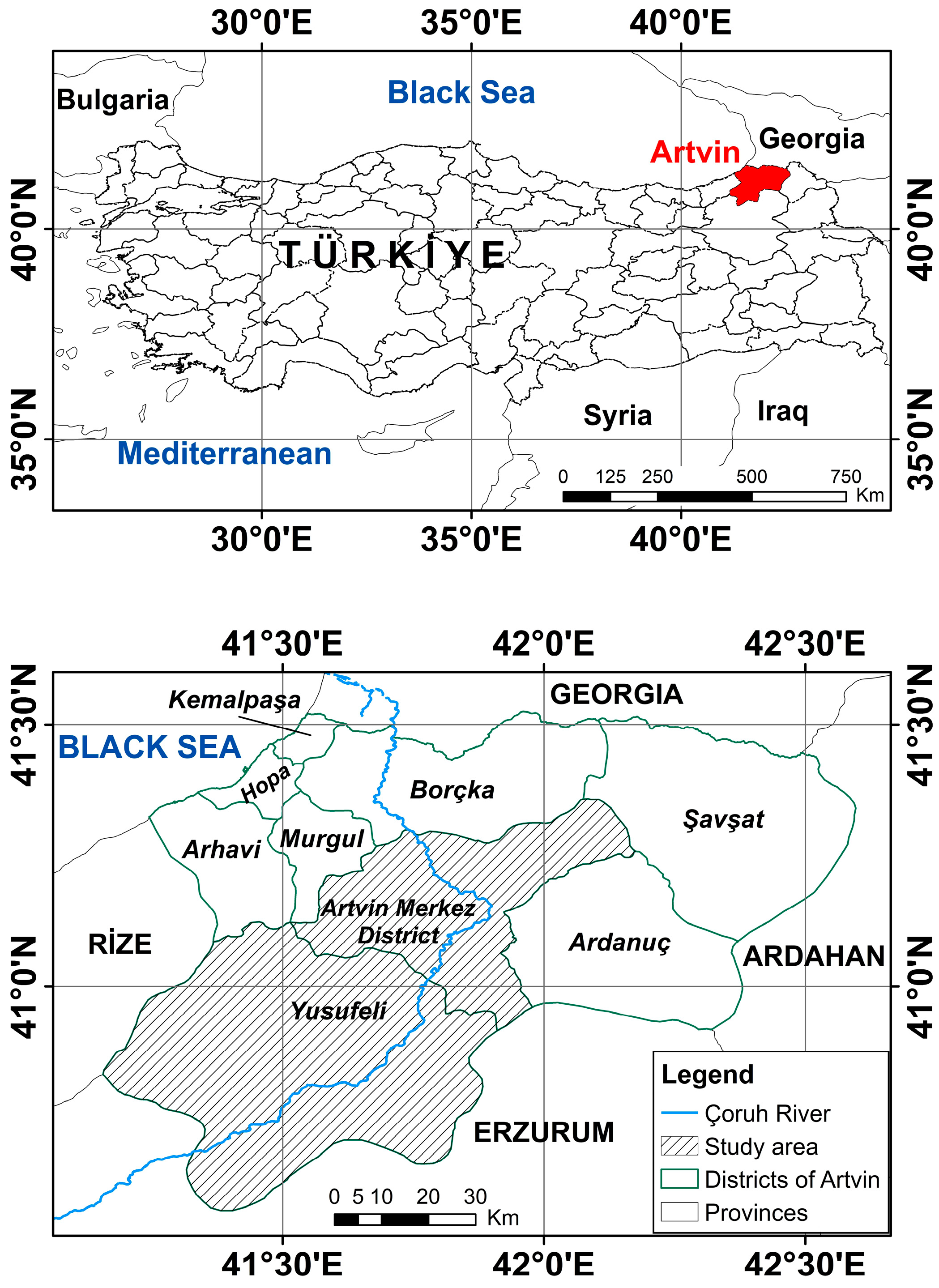
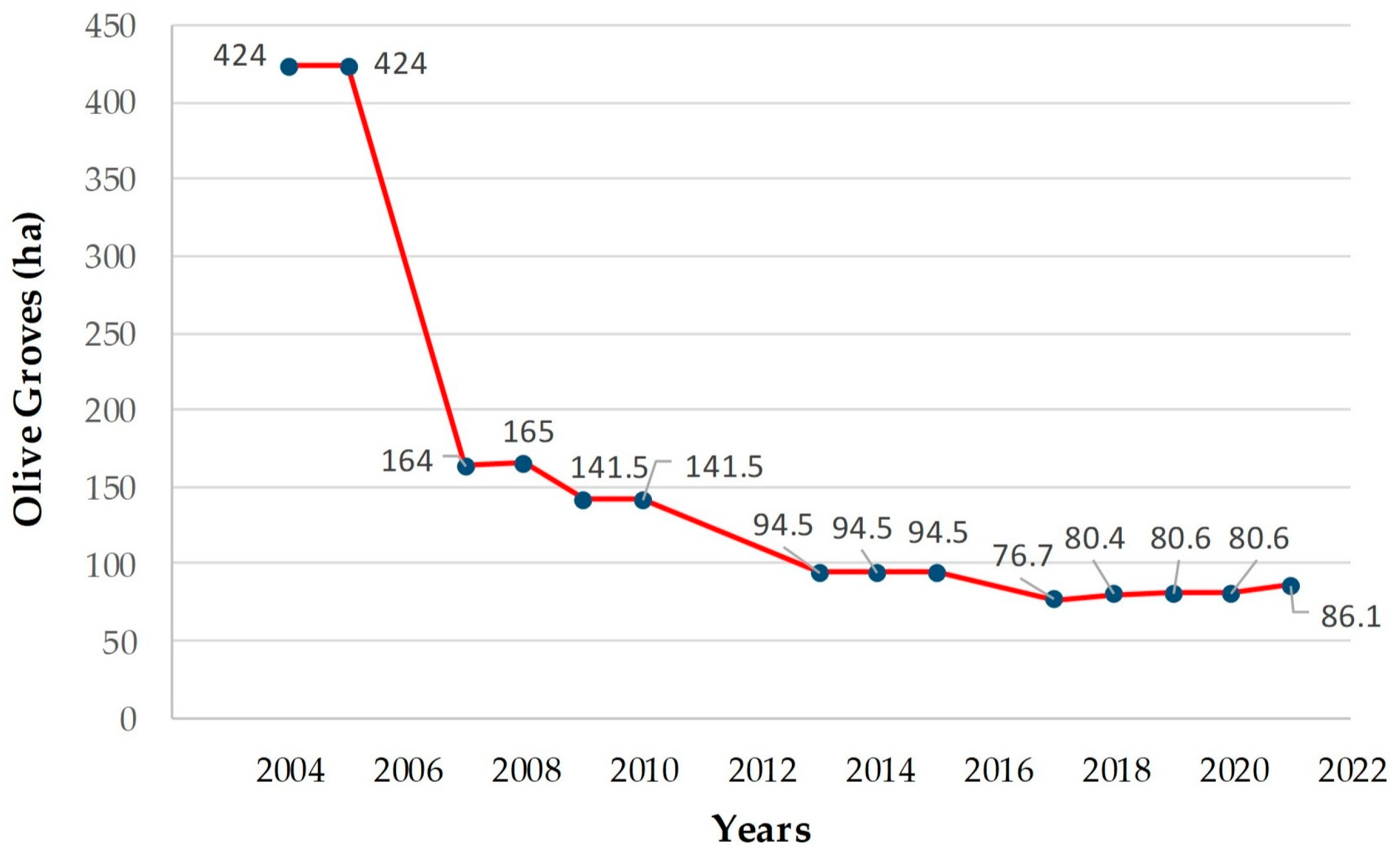
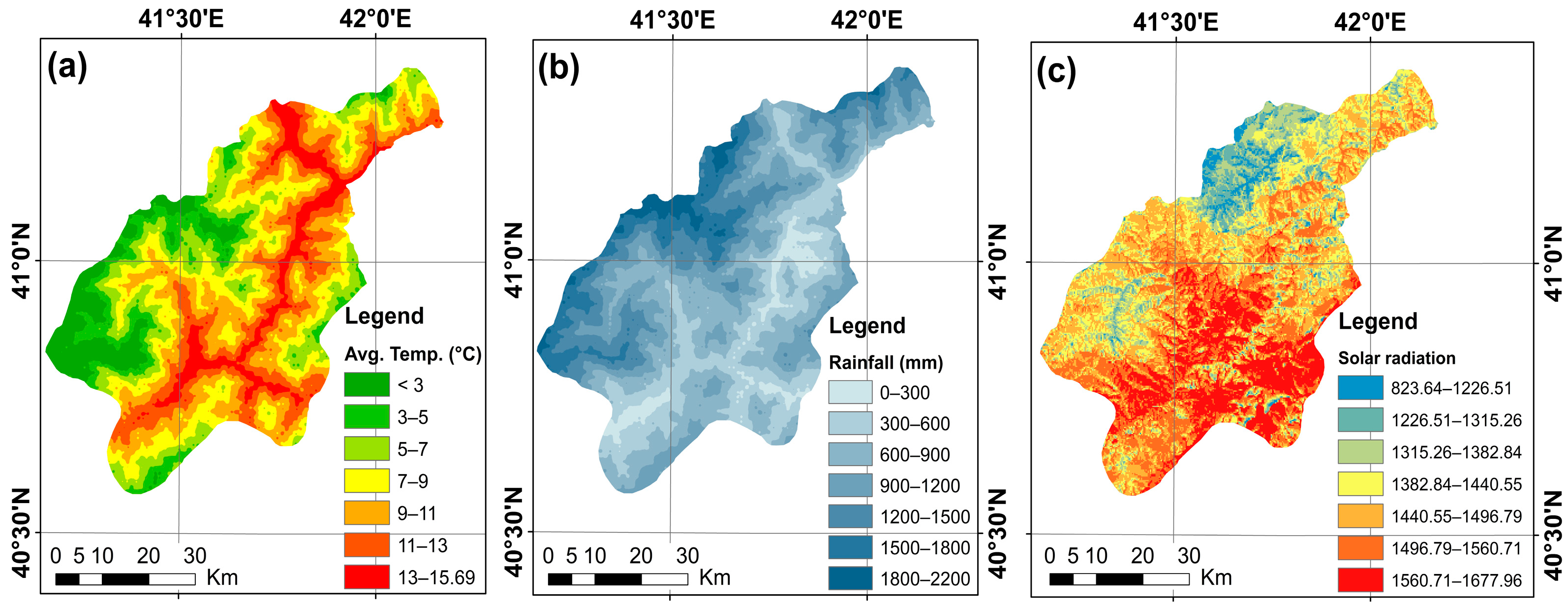
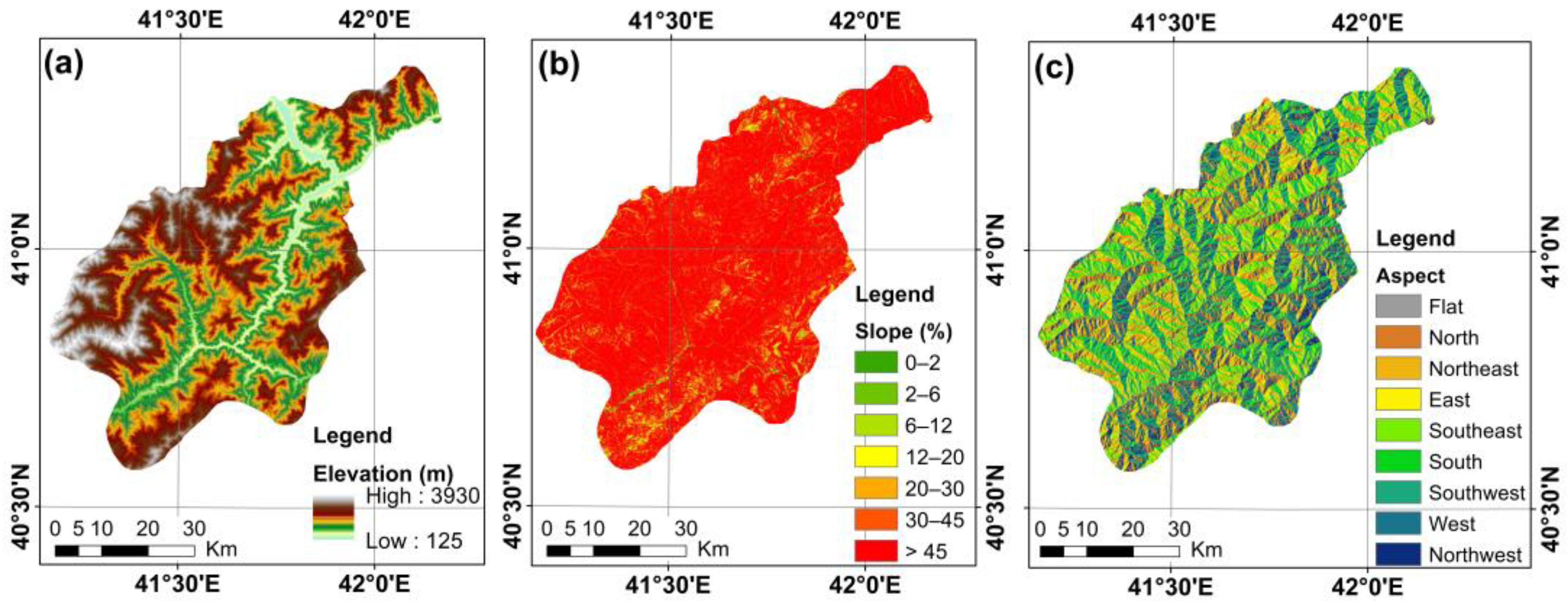




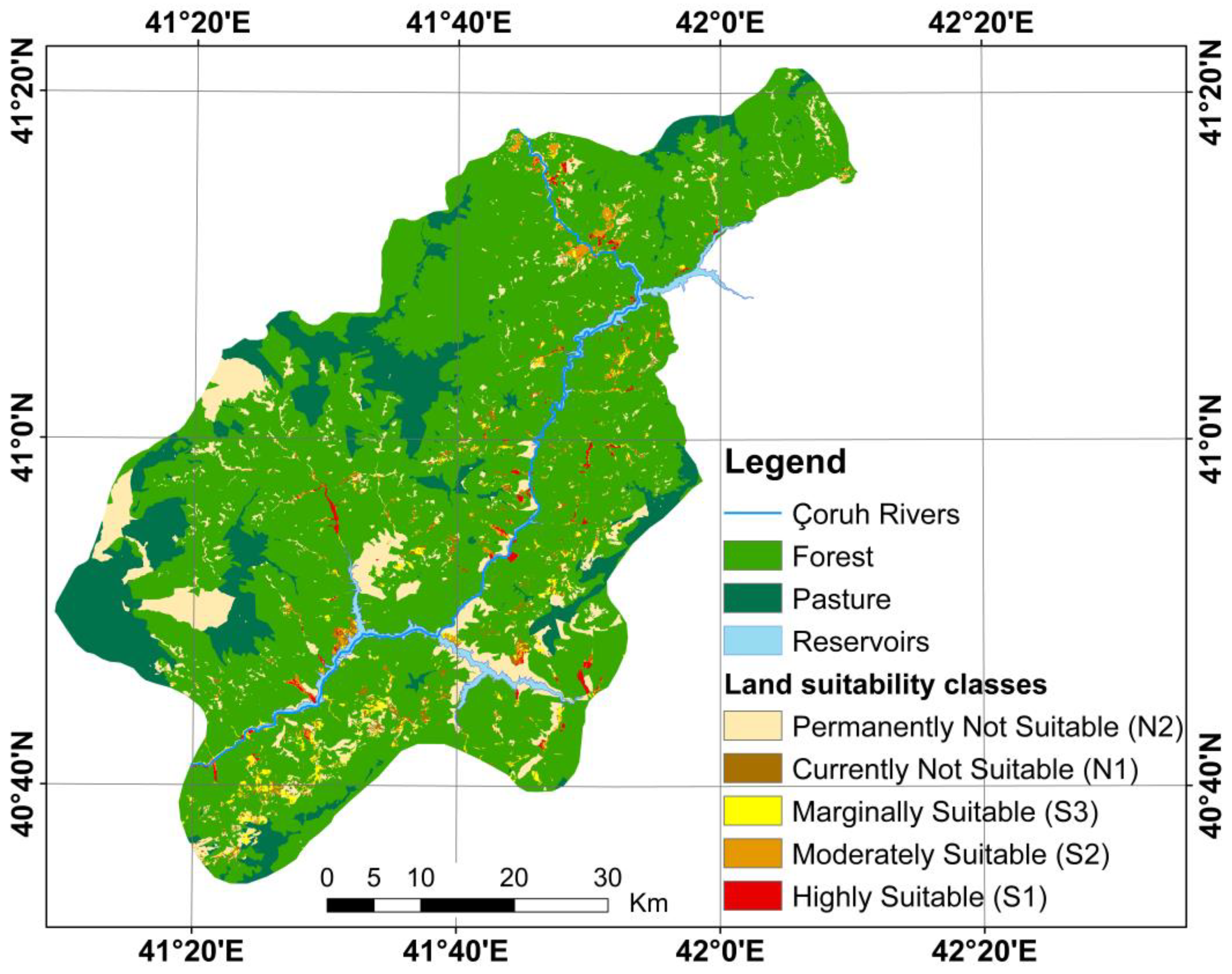



| Parameters | Unit | Data Type | Scale/Resolution | Data Source |
|---|---|---|---|---|
| Aver. annual precipitation | Mm | Point | Monthly | TSMS |
| Aver. annual temperature | °C | Point | Monthly | TSMS |
| Annual max. temperature | °C | Point | Monthly | TSMS |
| Annual min. temperature | °C | Point | Monthly | TSMS |
| Aspect | Categorical | Raster | 10 m | DEM |
| Elevation | M | Vector | 1/25,000 | GDM |
| Erosion Degree | Categorical | Vector | 1/25,000 | GDAR |
| Great soil group | Categorical | Vector | 1/25,000 | GDAR |
| Land cover | Categorical | Raster | 10 m | ESRI Land Cover |
| LUCC | Categorical | Vector | 1/25,000 | GDAR |
| LUCS | Categorical | Vector | 1/25,000 | GDAR |
| OSP | Categorical | Vector | 1/25,000 | GDAR |
| Slope | % | Raster | 10 m | DEM |
| Soil depth | M | Vector | 1/25,000 | GDAR |
| Solar Radiation | kWh/m2 | Raster | 10 m | Global Solar Atlas website |
| Parameters | VIF | TOL |
|---|---|---|
| Aspect | 1.11069 | 0.90034 |
| Average annual precipitation | 2.77318 | 0.36060 |
| Average annual temperature | 3.39812 | 0.29428 |
| Land cover | 1.13774 | 0.87894 |
| LUCC | 1.28196 | 0.78006 |
| LUCS | 1.62572 | 0.61511 |
| OSP | 1.50671 | 0.66370 |
| Slope | 1.25606 | 0.79614 |
| Soil depth | 1.47670 | 0.67719 |
| Solar Radiation | 1.38054 | 0.72435 |
| Parameter | Attributes | Value | Num. of Pixels | Ratio (%) |
|---|---|---|---|---|
| Elevation (m) | 130–510 | 1 | 252 | 9.68 |
| 510–890 | 2 | 2141 | 82.26 | |
| 890–1270 | 3 | 130 | 4.99 | |
| 1270–1650 | 4 | 57 | 2.19 | |
| 1650–2030 | 5 | 23 | 0.88 | |
| 2030–2410 | 6 | 0 | 0 | |
| 2410–2790 | 7 | 0 | 0 | |
| 2790–3170 | 8 | 0 | 0 | |
| 3170–3550 | 9 | 0 | 0 | |
| 3550–3930 | 10 | 0 | 0 | |
| Slope (%) | 0–2 | 1 | 49 | 1.88 |
| 2–6 | 2 | 13 | 0.51 | |
| 6–12 | 3 | 130 | 4.99 | |
| 12–20 | 4 | 162 | 6.22 | |
| 20–30 | 5 | 215 | 8.26 | |
| 30–45 | 6 | 443 | 17.02 | |
| >45 | 7 | 1591 | 61.12 | |
| Aspect | Flat | 1 | 40 | 1.53 |
| N | 2 | 328 | 12.59 | |
| NE | 3 | 104 | 4.00 | |
| E | 4 | 228 | 8.76 | |
| SE | 5 | 267 | 10.26 | |
| S | 6 | 381 | 14.64 | |
| SW | 7 | 291 | 11.18 | |
| W | 8 | 273 | 10.49 | |
| NW | 9 | 691 | 26.55 |
| Parameter | Attributes | Value | Num. of Pixels | Pixel (%) |
|---|---|---|---|---|
| Precipitation (mm) | 0–300 | 1 | 795 | 30.55 |
| 300–600 | 2 | 1621 | 62.27 | |
| 600–900 | 3 | 187 | 7.18 | |
| 900–1200 | 4 | 0 | 0 | |
| 1200–1500 | 5 | 0 | 0 | |
| 1500–1800 | 6 | 0 | 0 | |
| 1800–2200 | 7 | 0 | 0 | |
| Tmin (°C) | −7–2 | 1 | 0 | 0 |
| 2–4 | 2 | 19 | 0.73 | |
| 4–6 | 3 | 61 | 2.34 | |
| 6–8 | 4 | 349 | 13.41 | |
| 8–10 | 5 | 2098 | 80.60 | |
| >10 | 6 | 76 | 2.92 | |
| Tavg (°C) | −2.81–3 | 1 | 0 | 0 |
| 3–5 | 2 | 0 | 0 | |
| 5–7 | 3 | 157 | 4.99 | |
| 7–9 | 4 | 394 | 12.53 | |
| 9–11 | 5 | 117 | 3.72 | |
| 11–13 | 6 | 841 | 26.74 | |
| 13–15.69 | 7 | 1636 | 52.02 | |
| Tmax (°C) | 2–9 | 1 | 0 | 0 |
| 9–11 | 2 | 0 | 0 | |
| 11–13 | 3 | 0 | 0 | |
| 13–15 | 4 | 43 | 1.65 | |
| 15–17 | 5 | 64 | 2.46 | |
| 17–19 | 6 | 872 | 33.50 | |
| 19–21.86 | 7 | 1624 | 62.39 | |
| Solar radiation (kWh/m2) | 823.64–1226.51 | 1 | 0 | 0 |
| 1226.51–1315.26 | 2 | 226 | 8.68 | |
| 1315.26–1382.84 | 3 | 272 | 10.45 | |
| 1382.84–1440.55 | 4 | 823 | 31.62 | |
| 1440.55–1496.79 | 5 | 929 | 35.69 | |
| 1496.79–1560.71 | 6 | 279 | 10.72 | |
| 1560.71–1677.96 | 7 | 74 | 2.84 |
| Parameter | Attributes | Value | Num. of Pixels | Pixel (%) |
|---|---|---|---|---|
| GSG | Y (high mountain meadow soil) | 7 | 0 | 0 |
| X (basaltic soils) | 6 | 0 | 0 | |
| P (red–yellow podzolic soils) | 5 | 0 | 0 | |
| N (non-calcic brown forest soils) | 4 | 0 | 0 | |
| M (brown forest soils) | 3 | 2391 | 91.86 | |
| CE (chestnut soils) | 2 | 0 | 0 | |
| A (alluvial) | 1 | 70 | 2.69 | |
| Water bodies and urban fabric | 0 | 142 | 5.45 | |
| Soil depth (cm) | <90 (Deep) | 5 | 0 | 0 |
| 50–90 (Medium–deep) | 4 | 995 | 38.23 | |
| 20–50 (Shallow) | 3 | 177 | 6.80 | |
| 0–20 (Very Shallow) | 2 | 680 | 26.12 | |
| Litosolic | 1 | 609 | 23.40 | |
| Water bodies and urban fabric | 0 | 142 | 5.45 | |
| OSP | y (inadequate drainage) | 3 | 70 | 2.69 |
| t (stony) | 2 | 16 | 0.61 | |
| r (rocky) | 1 | 725 | 27.85 | |
| Water bodies and urban fabric | 0 | 1792 | 68.84 | |
| LUCS | w (wetness, inadequate drainage) | 4 | 70 | 2.68 |
| sw (soil inadequacy, wetness) | 3 | 0 | 0 | |
| es-se (slope, erosion, and soil inadequacy) | 2 | 1396 | 53.63 | |
| e (slope and erosion damage) | 1 | 995 | 38.23 | |
| Water bodies and urban fabric | 0 | 142 | 5.46 | |
| LUCC | I-II-III | 1–3 | 70 | 2.69 |
| IV | 4 | 552 | 21.21 | |
| V | 5 | 0 | 0 | |
| VI | 6 | 443 | 17.02 | |
| VII | 7 | 1396 | 53.63 | |
| VIII | 8 | 107 | 4.11 | |
| Water bodies and urban fabric | 0 | 35 | 1.34 | |
| Erosion degree | Very weak | 1 | 70 | 2.69 |
| Moderate | 2 | 995 | 38.23 | |
| Severe | 3 | 787 | 30.23 | |
| Very severe | 4 | 609 | 23.40 | |
| Null | 0 | 142 | 5.45 |
| Parameter | Attributes | Value | Num. of Pixels | Pixel (%) |
|---|---|---|---|---|
| Land cover | Water | 1 | 0 | 0 |
| Trees | 2 | 759 | 29.16 | |
| Grass (Rangeland) | 3 | 14 | 0.54 | |
| Flooded Vegetation | 4 | 6 | 0.22 | |
| Crops | 5 | 0 | 0 | |
| Scrub/shrub | 6 | 1461 | 56.13 | |
| Built Area | 7 | 318 | 12.22 | |
| Bare Ground | 8 | 45 | 1.73 | |
| Snow/ice/clouds | 9–10 | 0 | 0 |
Disclaimer/Publisher’s Note: The statements, opinions and data contained in all publications are solely those of the individual author(s) and contributor(s) and not of MDPI and/or the editor(s). MDPI and/or the editor(s) disclaim responsibility for any injury to people or property resulting from any ideas, methods, instructions or products referred to in the content. |
© 2023 by the authors. Licensee MDPI, Basel, Switzerland. This article is an open access article distributed under the terms and conditions of the Creative Commons Attribution (CC BY) license (https://creativecommons.org/licenses/by/4.0/).
Share and Cite
Ozalp, A.Y.; Akinci, H. Evaluation of Land Suitability for Olive (Olea europaea L.) Cultivation Using the Random Forest Algorithm. Agriculture 2023, 13, 1208. https://doi.org/10.3390/agriculture13061208
Ozalp AY, Akinci H. Evaluation of Land Suitability for Olive (Olea europaea L.) Cultivation Using the Random Forest Algorithm. Agriculture. 2023; 13(6):1208. https://doi.org/10.3390/agriculture13061208
Chicago/Turabian StyleOzalp, Ayse Yavuz, and Halil Akinci. 2023. "Evaluation of Land Suitability for Olive (Olea europaea L.) Cultivation Using the Random Forest Algorithm" Agriculture 13, no. 6: 1208. https://doi.org/10.3390/agriculture13061208
APA StyleOzalp, A. Y., & Akinci, H. (2023). Evaluation of Land Suitability for Olive (Olea europaea L.) Cultivation Using the Random Forest Algorithm. Agriculture, 13(6), 1208. https://doi.org/10.3390/agriculture13061208







